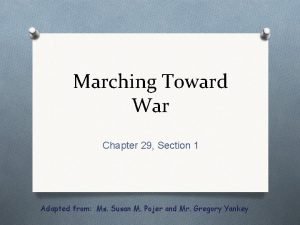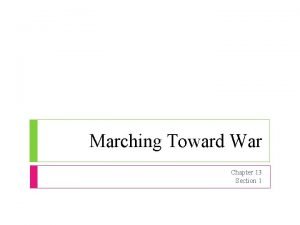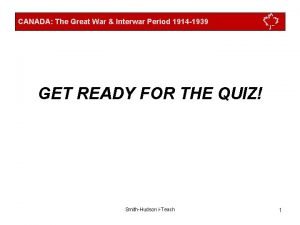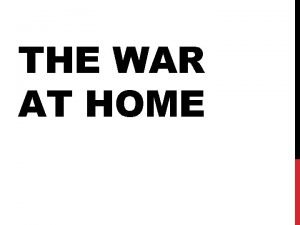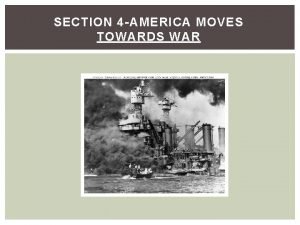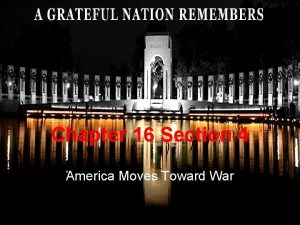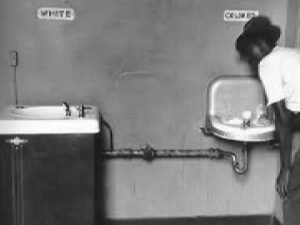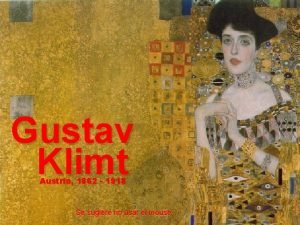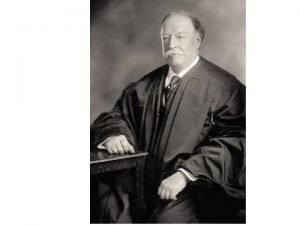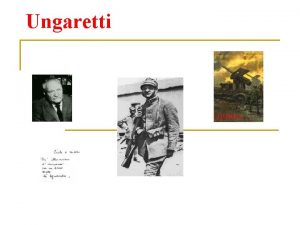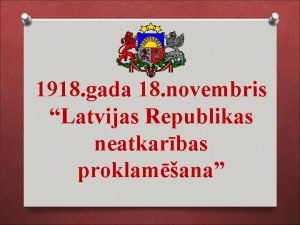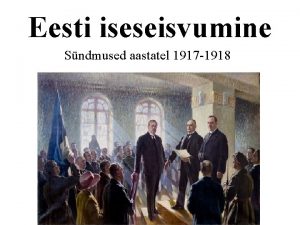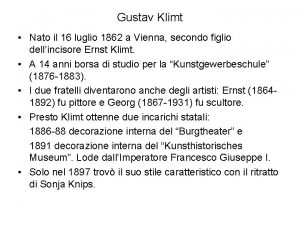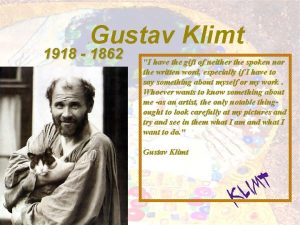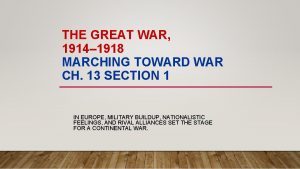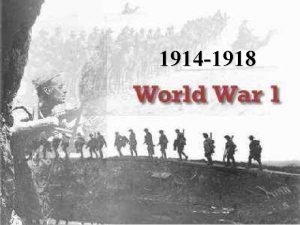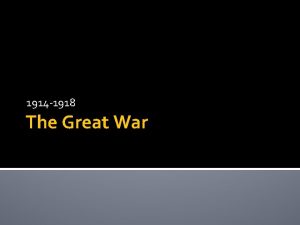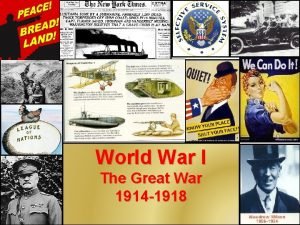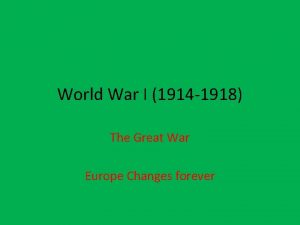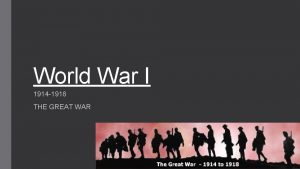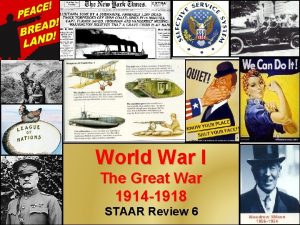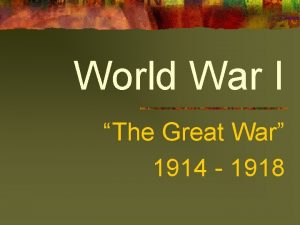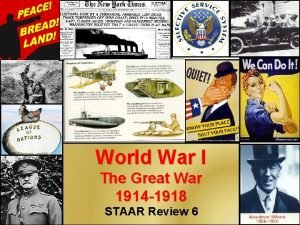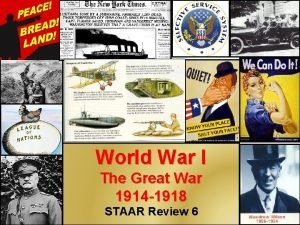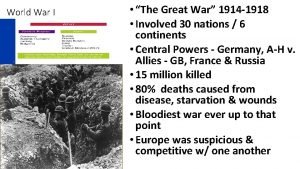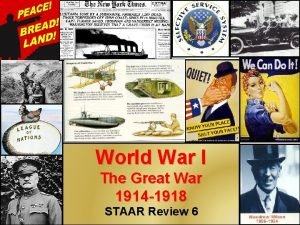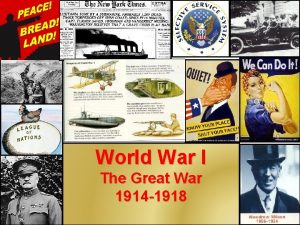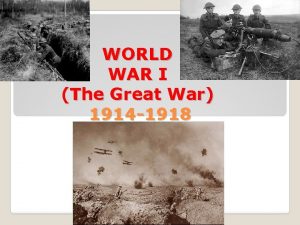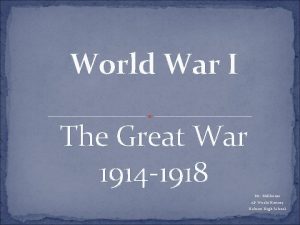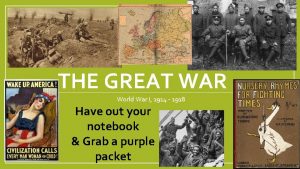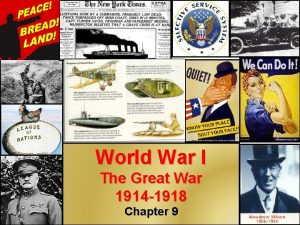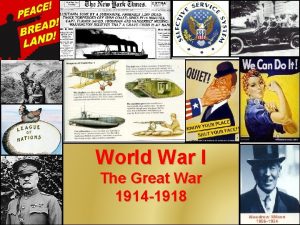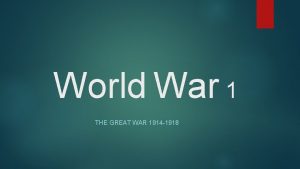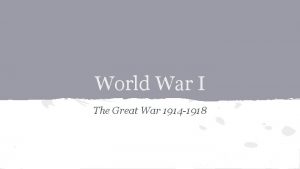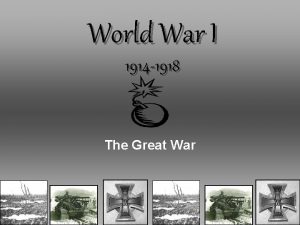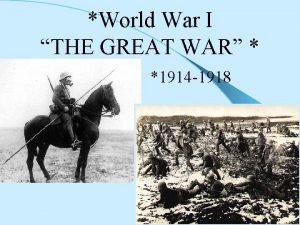The Great War 1914 1918 Marching Toward War




























- Slides: 28

The Great War, 1914– 1918 Marching Toward War Ch. 13 Section 1 In Europe, military buildup, nationalistic feelings, and rival alliances set the stage for a continental war.

Main Causes of World War I 1) The Rise of Nationalism 2) Imperialism 3) Militarism (arms race) 4) Alliance system 5) Assassination of the Arch Duke Franz Ferdinand of Austria-Hungary

Rising Tensions in Europe The Rise of Nationalism • Europe enjoys peace in late 1800 s – Considered the century of peace • BUT, problems lie below surface 6 Nations were rivals for power in Europe – called the Great Powers - Germany, Great Britain, France, Austria-Hungary, Italy & Russia - Competed economically and for land • Nationalism in the Balkans leads many groups to demand independence Alliances began to form

Map of Europe Pre-WWI

Rising Tensions in Europe Imperialism Competition for colonies stirs mistrust among European nations • Mutual animosity spurs European countries to Militarism European nations engaged in arms race • Militarism—policy of glorifying military power, preparing army • Increase competition and mistrust

Tangled Alliances Bismarck (Prussia) Forges Early Pacts Otto von Bismarck unified Germany Otto von Bismarck worked to keep peace in Europe after 1871 • Believes France wants revenge for loss in 1870 Franco-Prussian War Seeks to isolate the French with a series of treaties and alliances: - signs treaty with Russia in 1881 - forms Triple Alliance— Germany, Austria. Hungary, Italy—in 1882

Tangled Alliances Shifting Alliances Threaten Peace • Kaiser Wilhelm II become German ruler in 1888 • Foreign policy changes begin in 1890 with dismissal of Bismarck - alliance with Russia dropped; Russia then allies with France - Created a possible two front war for Germany - effort to strengthen German navy, which alarms Britain • Britain, France, Russia form Triple Entente alliance in 1907

Crisis in the Balkans A Restless Region • Many groups in Balkans win independence during early 1900 s from the Ottoman Empire • New nation of Serbia made up largely of Slavs • Austria-Hungary annexes Slavic region Bosnia and Herzegovina (1908) • Serbia outraged, sees itself as rightful ruler of these Slavic lands

Crisis in the Balkans A Shot Rings Throughout Europe • Serbian rebel kills Austro. Hungarian royal official (Arch Duke Franz Ferdinand his wife) in June 1914 • Austria declares war on Serbia; Russia comes to aid of Serbia (Stop)

Europe Plunges into War Ch. 13. 2 One European nation after another is drawn into a large and industrialized war that results in many casualties.

The Great War Begins Armies on the March • Russia moves troops to its borders with Austria and Germany • Germany declares war on Russia, quickly attacks France • Great Britain declares war on Germany

The Great War Begins Nations Take Sides • By mid-August 1914, two sides at war throughout Europe: - Central Powers— Germany, Austria. Hungary, Ottoman Empire, Bulgaria (and other nations) - Allies—Britain, France, Russia, Italy (and other nations); U. S. in 1917.

A Bloody Stalemate The Conflict Grinds Along • Schlieffen Plan—German plan to defeat France, then fight Russia • German army quickly advances to outskirts of Paris • Forced to retreat at First Battle of the Marne • Schlieffen Plan fails; Germany has to fight twofront war

A Bloody Stalemate War in the Trenches Western Front—heavy battle zone in northern France Conflict descends into trench warfare —armies fighting from trenches • Battles result in many deaths, small land gains • Life in trenches is miserable, difficult, unsanitary • New weapons only lead to more deaths • Massive losses for both sides at 1916 battles of Verdun and Somme

The Battle on the Eastern Front Early Fighting • Eastern Front—site of main fighting along the German. Russian border • Russians push into Austria and Germany, but soon forced to retreat Russia Struggles • Russia’s war effort suffering by 1916; many casualties, few supplies • Huge size of Russian army keeps it a formidable force - prevents Germany from sending more troops to the Western Front (2 front war)

A Global Conflict Chapter 13 Section 3

Main Idea • World War I spread to several continents and required the full resources of many governments. • The war propelled the United States to a new position of international power, which it holds today.

Introduction • WWI was much more than a European conflict. • Australia and Japan entered the war on the Allies’ side. • India supplied troops to fight alongside their British rulers. • Ottoman Turks and Bulgaria allied themselves with Germany and Central Powers. • Countries were searching for other allies and new war fronts to tip the balance.

War Affects the World • Main combatants looked beyond Europe for a way to end the stalemate. • However, none of the alliances they formed or new battlefronts they opened did much to end the slow and grinding conflict.

America Joins the Fight • 1917 – the focus of the war shifted to the high seas. • Germans intensified the submarine warfare that had raged in the Atlantic Ocean. • Germans announced their policy of unrestricted submarine warfare. – Their submarines would sink any ship without warning in the waters around Britain. • Germans used their submarines (U-boats) to stop supplies from reaching the Allies.

Lusitania • May 7, 1915 – German U-boat sunk the British passenger ship Lusitania. – 1, 198 dead • 128 U. S. citizens • Germany claimed the ship was carrying ammunition. – True • American public = outraged • President Woodrow Wilson sent a strong protest to Germany. • After two more attacks, Germany agreed to stop attacking neutral or passenger ships.

A Flawed Peace Chapter 13 Section 4

Treaty of Versailles— 1918 Allied Leaders from 32 nations met in Paris, France to discuss the terms of peace. The BIG FOUR made most of the decisions • David Lloyd George (PM of England) • Georges Clemenceau (Premier of France) • Vittorio Orlando (Premier of Italy) • Woodrow Wilson (President of the US)

David Lloyd George Prime Minister of England • A moderating influence on both the harsh demands of Georges Clemenceau and the idealistic proposals of Woodrow Wilson • To a large extent, shaped the final agreement • He later concluded that the treaty was a failure • Predicted that Europe would experience a renewed war within twenty years

Georges Clemenceau Premier of France • Georges Clemenceau wanted the destruction of Germany • His nickname was ‘The Tiger’ because of his aggressive nature.

Vittorio Orlando Premier of Italy • Clashed with Woodrow Wilson over Italy's territorial demands • The terms of the Versailles Peace Treaty undermined Orlando's position

Woodrow Wilson President of the United States • Supported the Versailles Treaty • Insisted that his Fourteen Points should serve as a basis for the US signing of the peace treaty • His ideas were considered idealistic

Provisions of the Treaty of Versailles I. Germany surrendered areas under their control A. In Germany 1. the Alsace-Lorraine region to France 2. the Saar Valley (coal mine region) to the League of Nations 3 minor border regions to Denmark and Belgium 4. Poland was created from parts of Russia, Germany, and Austria-Hungary
 Chapter 13 section 1 marching toward war answer key
Chapter 13 section 1 marching toward war answer key Serbian nationalist
Serbian nationalist Chapter 29 marching toward war
Chapter 29 marching toward war Marching toward war
Marching toward war Chapter 13 marching toward war
Chapter 13 marching toward war 1914 1918
1914 1918 Chapter 16 lesson 2 challenges to slavery
Chapter 16 lesson 2 challenges to slavery Who reorganized the war industries board in 1918
Who reorganized the war industries board in 1918 Chapter 24 section 4 america moves toward war
Chapter 24 section 4 america moves toward war America moves toward war section 4
America moves toward war section 4 America moves toward war
America moves toward war Mapa ukrainy 1918
Mapa ukrainy 1918 1 decembrie 1918 university
1 decembrie 1918 university 1918-1862
1918-1862 Lklimt
Lklimt Louisiana 1918 poll tax receipt
Louisiana 1918 poll tax receipt 1918-1862
1918-1862 Hammer v. dagenhart
Hammer v. dagenhart 1 decembrie clasa 1
1 decembrie clasa 1 Ommfps 1918/2011
Ommfps 1918/2011 Locvizza
Locvizza Louisiana 1918 poll tax receipt
Louisiana 1918 poll tax receipt Peintre viennois
Peintre viennois 1918 18 novembris
1918 18 novembris 1918 18 novembris
1918 18 novembris Eesti iseseisvumine 1918
Eesti iseseisvumine 1918 Ritratto di fritza riedler
Ritratto di fritza riedler 1918-1862
1918-1862 Lịch sử hà nội từ năm 1802 đến năm 1884
Lịch sử hà nội từ năm 1802 đến năm 1884


